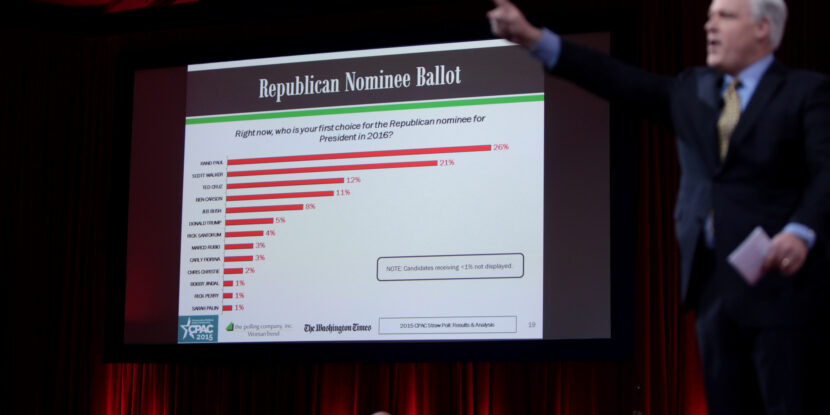The most recent national poll released, a CNN/ORC poll, put Bush ahead of Walker by three points, 16 percent to 13 percent, with Rand Paul in third place with 12 percent. That poll didn’t matter. In fact, none of the national polls hold any weight in predicting the viability of candidates moving forward.
The media continues to act as if Jeb Bush, Rand Paul, and even sometimes Chris Christie are top tier candidates, based on their ability to compete in the money primary.
A much more interesting, and I believe more telling, barometer of a candidate’s viability can be found by crunching the numbers in the March NBC News/Wall Street Journal survey. The survey asked potential voters if they could see themselves supporting a candidate or not, or if they had heard their name at all. By subtracting the percentage of people who said they couldn’t see themselves voting for a candidate from the percentage who said they could, you come up with that candidate’s net favorability score. This measure allows for a very different take on the 2016 field. In using this metric, the candidates can be split into three main categories.
The first category includes candidates who have a large net favorability but aren’t well known. This allows for the candidates to capitalize on their positive image and build on it with the undecided voters. They do, however, need to be very careful and deliberate in shaping themselves in the eyes of the voters who remain undecided about them. The four potential candidates in this category are:
- Scott Walker: +36 net favorability, 30% don’t know or aren’t sure
- Marco Rubio: +30 net favorability, 18% don’t know or aren’t sure
- Ben Carson: +23 net favorability, 41% don’t know or aren’t sure
- Bobby Jindal: +11 net favorability, 39% don’t know or aren’t sure
These candidates are in the top tier based on this metric and are in the best position moving forward, as they have the largest pool of undecided voters to entice, and they already start with a base of support.
The next category includes candidates who have a slightly positive net favorability but are well known. While these candidates start with a good base of support among the voters, they have very little room for improvement. The five candidates in this category are:
- Rand Paul: +9 net favorability, 11% don’t know or aren’t sure
- Jeb Bush: +7 net favorability, 9% don’t know or aren’t sure
- Rick Perry: +5 net favorability, 14% don’t know or aren’t sure
- Ted Cruz: +2 net favorability, 22% don’t know or aren’t sure
- Rick Santorum: 0 net favorability, 20% don’t know or aren’t sure
The voters have largely already decided on them, and they would have to overcome a large hurdle in order to win them over. This is a much less desirable position for a politician to be in, as they face strong headwinds against them, with a majority of people already having an opinion of them. This is also in stark contrast to the conventional wisdom, as it puts Rand Paul and Jeb Bush in positions that are much weaker than the media portrays.
The final category includes the candidates who have negative favorability from the outset. This list includes:
- Carly Fiorina: -7 net favorability, 57% don’t know or aren’t sure
- Chris Christie: -25 net favorability, 11% don’t know or aren’t sure
- Lindsey Graham: -31 net favorability, 29% don’t know or aren’t sure
- Donald Trump: -51 net favorability, 3% don’t know or aren’t sure
These candidates would have to go to great, and quite frankly, amazing lengths to overcome their negative image. The only candidate on this list who could reasonably overcome the negativity would be Carly Fiorina, but only because she still has a large pool of undecided voters. Similar to the first category, the right moves could raise her favorability by winning over undecided voters. On the other hand, Chris Christie, who is still seen as a somewhat viable dark horse to many, has a large group of voters opposed to him, so much so that it would be highly unlikely for him to win.
It is far less important that a candidate get 11 percent support nationwide if they have no avenues to improve those numbers. By that same token, a candidate with 2 percent support nationwide could catch fire if they have a pool of undecided voters to win over. This new barometer gives us a much more accurate view of a candidate’s potential to build a base of support in the primaries.
Frank Cannon is the president of American Principles in Action.


